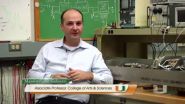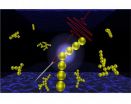(Press-News.org) COLUMBUS, Ohio – The secret to boosting the language skills of preschoolers with disabilities may be to put them in classrooms with typically developing peers, a new study finds.
Researchers found that the average language skills of a child's classmates in the fall significantly predicted the child's language skills in the spring – especially for children with disabilities.
The results support inclusion policies in schools that aim to have students with disabilities in the same classrooms alongside their typically developing peers, said Laura Justice, co-author of the study and professor of teaching and learning at The Ohio State University.
"Students with disabilities are the ones who are affected most by the language skills of the other children in their class," Justice said.
"We found that children with disabilities get a big boost in their language scores over the course of a year when they can interact with other children who have good language skills."
In fact, after one year of preschool, children with disabilities had language skills comparable to children without disabilities when surrounded by highly skilled peers in their classroom.
"The biggest problem comes when we have a classroom of children with disabilities with no highly skilled peers among them," Justice said. "In that case, they have limited opportunity to improve their use of language."
Justice conducted the study with Jessica Logan, a senior researcher in education, and Tzu-Jung Lin, assistant professor of educational studies, both at Ohio State; and Joan Kaderavek, a professor of education at the University of Toledo.
Their study will appear in the journal Psychological Science.
The study involved 670 preschool-aged children enrolled in 83 early childhood special education classrooms in Ohio. About half of the children had an Individualized Education Plan, signaling presence of a disability. Between 25 and 100 percent of children in each classroom had a disability.
All children's language skills were measured in the fall and spring of the academic year with a commonly used test called the Descriptive Pragmatics Profile.
The average score of all children in an individual classroom was used to determine each child's relative status in terms of language development, and whether their classmates were more highly skilled, less skilled or average.
While all children's language skills were affected somewhat by the skill levels of their classmates, the effect was strongest for those with disabilities, the study found.
For those children with disabilities who were in classrooms with the most highly skilled peers, language scores in the spring were about 40 percent better than those of children with disabilities who were placed with the lowest-ranked peers.
Students who had no disabilities showed about a 27 percent difference in scores between those with the highest-ranked peers and the lowest-ranked peers.
This study, like others, finds that the most highly skilled students are the ones whose language improvement is least affected by the skill of their classmates, Justice said.
"The highly skilled children aren't hurt by being in classrooms with children who have disabilities," she said.
"But children with disabilities are vulnerable if they aren't placed with more highly skilled peers."
Justice said she and her colleagues are currently doing research that directly compares the effects teachers have on language development versus the effect of peers.
Early results suggest teachers matter most, "but peers definitely have an impact on language development," she said.
Peers help because they spend more time one-on-one with their fellow classmates than teachers can. Children with disabilities have the opportunity to observe, imitate and model the language use of their peers who do not have disabilities.
"In a sense, the typically developing children act as experts who can help their classmates who have disabilities," Justice said.
Statistics from the U.S. Department of Education show that more than half of preschoolers with disabilities are enrolled in early childhood classrooms with typically developing peers.
Justice said these results suggest that all preschoolers with disabilities would benefit from inclusion policies.
"We have to give serious thought to how we organize our classrooms to give students with disabilities the best chance to succeed," she said.
INFORMATION:
Contact: Laura Justice, (614) 292-1045; Justice.57@osu.edu
Written by Jeff Grabmeier, (614) 292-8457; Grabmeier.1@osu.edu
Children with disabilities benefit from classroom inclusion
Language skills improve when preschoolers with disabilities are included in classes with typical peers
2014-07-28
ELSE PRESS RELEASES FROM THIS DATE:
Study shows new link between obesity in the young and the lowering of age of puberty
2014-07-28
A new link has been identified between obesity in childhood and the lowering of the age of puberty.
The research which discovered the link, carried out at Plymouth University Peninsula Schools of Medicine and Dentistry, is published in the Journal of Clinical Endocrinology and Metabolism.
The study focuses on a protein called sex hormone-binding globulin (SHBG), the regulation and role of which in children are poorly defined. SHBG binds to the sex hormones androgen and oestrogen. SHGB levels are initially high in childhood but decline significantly before puberty, in ...
Henry Ford study: Burnout impacts transplant surgeons
2014-07-28
VIDEO:
Despite saving thousands of lives yearly, nearly half of organ transplant surgeons report a low sense of personal accomplishment and 40 percent feel emotionally exhausted, according to a new national...
Click here for more information.
DETROIT – Despite saving thousands of lives yearly, nearly half of organ transplant surgeons report a low sense of personal accomplishment and 40% feel emotionally exhausted, according to a new national study on transplant surgeon burnout.
The ...
Many people never grow out of their growing pains
2014-07-28
Over the years, many adolescents have been forced to accept the diagnosis "growing pains" when they complained about pain in their knees. A new PhD study involving 3,000 adolescents has now shown that the knee pain often carries on:
"We can see from the study that one in three young people between the ages of 12 and 19 experience problems with pain in their knees. Seven percent of the adolescents experience daily knee pain in the front of the knee," says physiotherapist and PhD Michael Skovdal Rathleff from Aarhus University, and continues:
"More than half still have ...
Glow in space is evidence of a hot bubble in our galaxy
2014-07-28
VIDEO:
Dr. Massimilano Galeazzi discusses his work on a sounding rocket, sent into the atmosphere to search for answers about the universe.
Click here for more information.
CORAL GABLES, Fla. (July 27, 2014) — When we look up to the heavens on a clear night, we see an immense dark sky with uncountable stars. With a small telescope we can also see galaxies, nebulae, and the disks of planets. If you look at the sky with an X-ray detector, you would see many of these same familiar ...
Interfering with interferon
2014-07-28
Using the body's natural virus killers to prevent and treat HIV infection has been problematic until now because of the strong inflammatory response these molecules can arouse as they get rid of the invaders. Now, collaborative research conducted by scientists at the Weizmann Institute and the National Institutes of Health (NIH) have demonstrated how suppressing the activity of these molecules – interferons – around the time of infection could have long-term implications for the course of the disease. Their research appeared in Nature.
Interferons, named for their ability ...
Industrial lead pollution beat explorers to the South Pole by 22 years and persists today
2014-07-28
RENO – Norwegian explorer Roald Amundsen became the first man to reach the South Pole in December of 1911. More than 100 years later, an international team of scientists led by Joe McConnell of Nevada's Desert Research Institute (DRI) have proven that air pollution from industrial activities arrived long before.
Using data from 16 ice cores collected from widely spaced locations around the Antarctic continent, including the South Pole, McConnell's team created the most accurate and precise reconstruction to date of lead pollution over the Earth's southernmost continent. ...
Building 'invisible' materials with light
2014-07-28
A new method of building materials using light, developed by researchers at the University of Cambridge, could one day enable technologies that are often considered the realm of science fiction, such as invisibility cloaks and cloaking devices.
Although cloaked starships won't be a reality for quite some time, the technique which researchers have developed for constructing materials with building blocks a few billionths of a metre across can be used to control the way that light flies through them, and works on large chunks all at once. Details are published today (28 ...
Superconductivity could form at high temperatures in layered 2D crystals
2014-07-28
An elusive state of matter called superconductivity could be realized in stacks of sheetlike crystals just a few atoms thick, a trio of physicists has determined.
Superconductivity, the flow of electrical current without resistance, is usually found in materials chilled to the most frigid temperatures, which is impractical for most applications. It's been observed at higher temperatures–higher being about 100 kelvin or minus 280 degrees below zero Fahrenheit–in copper oxide materials called cuprate superconductors. But those materials are brittle and unsuitable for fabricating ...
Lifestyle choices may affect the long-term heart health of childhood cancer survivors
2014-07-28
A new study has found that following a healthy lifestyle may lower childhood cancer survivors' risk of developing the metabolic syndrome. Published early online in CANCER, a peer-reviewed journal of the American Cancer Society, the findings indicate that children with cancer and adults who had cancer when they were children should receive information about how their lifestyle may influence their long-term health.
Adults who had cancer as children are known to be at increased risk for the metabolic syndrome, a group of risk factors that increases the likelihood of developing ...
Nicotine found to inhibit DNA-strand break caused by a certain carcinogen in smoke
2014-07-28
A new in vitro study has revealed that nicotine and cotinine, a metabolite of nicotine, can potentially inhibit DNA damage caused by a certain carcinogen in smoke.
The carcinogen 4-(methylnitrosamino)-1-(3-pyridyl)-1-butanone or NNK is produced during the curing of tobacco leaves and ultimately ends up in the tobacco smoke. Once inhaled, it is metabolised in the lung and liver, where it is activated by a variety of enzymes called Cytochrome P450 (CYP). Previous research in mice has revealed that nicotine can partially interfere with the activation of NNK, and this has ...
LAST 30 PRESS RELEASES:
Researchers use robotics to find potential new antibiotic among hundreds of metal complexes
Gut bacteria changes at the earliest stages of inflammatory bowel disease
Scientists develop new way to “listen in” on the brain’s hidden language
Brain research: “Pulse generators” grow and shrink as memories are formed
For teens, any cannabis use may have impact on emotional health, academic performance
School meals could unlock major gains for human and planetary health
Menopause hormone therapy does not appear to impact dementia risk
Signature patterns of brain activity may help predict recovery from traumatic brain injury
Dresden study uncovers new key mechanism in cancer cells
New species are now being discovered faster than ever before, study suggests
Cannabis-based products show limited short-term benefit for chronic pain, with increased risk of adverse effects
Cannabis products with more THC slightly reduce pain but cause more side effects
Clearing the brain of aging cells could aid epilepsy and reduce seizures
Brain injuries linked with potential risk of suicide, new study finds
New technique lights up where drugs go in the body, cell by cell
New study finds movement of fishing fleets can reveal shifts in marine ecosystems
Embargoed: New evidence points to potential treatment for vascular dementia
Study uncovers disrupted brain balance in alcohol dependence
Working in groups can help Republicans and Democrats agree on controversial content moderation online
Structural findings reveal how distinct GPCR ligands create different levels of activation
Anything-goes “anyons” may be at the root of surprising quantum experiments
UC review: Maximizing workplace opportunity for veterans
From generation to complex control: Metasurfaces make perfect vortex beams "within reach"
Thin-film lithium niobate-based detector: recent advances and perspectives
Exploring why some people may tend to persistently make bad choices
How cells balance their protein levels
Nirsevimab vs RSVpreF vaccine for RSV–related hospitalization in newborns
Effectiveness and impact of maternal RSV immunization and nirsevimab on medically attended RSV in US children
AI gives scientists a boost, but at the cost of too many mediocre papers
Next-generation vision model maps tree growth at sub-meter precision
[Press-News.org] Children with disabilities benefit from classroom inclusionLanguage skills improve when preschoolers with disabilities are included in classes with typical peers




